|
Photos
Resources
Your Voice
|
Forest Service organizes fight against alien species
August 15, 2003
 |
| Purple loosestrife infests a wetland in the Superior National Forest. (MPR Photo/Stephanie Hemphill) |
Virgina, Minn. — Jack Greenlee wades through chest-high grasses, rushes, wild raspberries and roses. He reaches for a clump of lacy plants with soft purple flowers. He yanks one out of the ground, and paints a picture with words.
"(It's) got an extensive root system, big and woody," Greenlee says. "(The) plant itself is six feet tall, with these spikes of beautiful light purple flowers. There are lots of them, so it's very eyecatching."
It's purple loosestrife, and it's infesting Johnson Creek, 13 miles north of Virginia. The creek flows into a wetland here, near a highway. This area is a favorite spot for mallards and other water birds. But Greenlee says the loosestrife could change that.
 | |||
"As the invasion of a marsh progresses, there's more and more loosestrife and fewer and fewer native marsh plants, consequently fewer resources for waterfowl that might stop," Greenlee says.
That's because loosestrife isn't on the menu for a mallard. Purple loosestrife is one of several plants that arrived in North America in grain shipments a hundred years ago. They've been spreading across the continent since then. Some, like loosestrife, have also been grown in gardens.
"It came from Europe, and there are different insects that eat the plant there," Greenlee says. "But when it was brought here, the insects didn't come along, there's no insect predators, viruses, molds, so consequently able to thrive."
Because they have no natural predators, the exotic plants can shoulder aside the native ones. That can affect everything in the complex web of life.
 | |||
"Once they're there, they'll always be there, can't ever restore (the habitat) truly to what it used to be," says Greenlee. "It will always be a component, so aggressive and hard to get rid of. So it's kind of a one-way street."
Greenlee is taking an inventory of all the non-natives in the Superior National Forest. He says they usually show up along roads and other places where the land is already disturbed. People bring them, without knowing it, on their tires or their boats.
"And here's another species we're tracking, it's common tansy," Greenlee says as he comes across another non-native plant.
Greenlee is hoping to recruit some vigilantes to keep an eye out for non-natives, especially in the Boundary Waters Canoe Area and other remote parts of the Superior National Forest.
 | |||
"It's a large, pretty intact ecosystem without lot of invasives yet," he says. "It's a lot harder to get into, there's not a lot of people driving down the roads, so the more eyes the better."
Saturday, about a dozen people will spend the day learning how to recognize purple loosestrife, tansy, and the other invasive non-natives. Greenlee wants his recruits to report to him when they see some. Or even to pull them up.
"We've had patches pulled in the Boundary Waters before," he says. "Our seasonal crews revisit sites and don't see them after pulling them. When you have small infestations, can be effective."
Greenlee hopes next year more people will want to join his volunteer team, and help him prevent a major infestation of non-native invasive plants in the Superior National Forest.
|
News Headlines
|
Related Subjects
|
